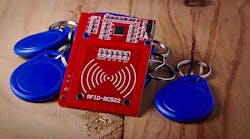In an episode of “Law and Order,” a suspected perpetrator was tracked to a hotel, and it was discovered that he was lying about his whereabouts at a certain time. How did they do that?
They checked the hotel security system and discovered that he had opened the door to his room with his keycard at Time X, as well as Time Y, which put him out of his room during this period. The murder timeline suggested that the murder was committed between the time he had exited his room and the time he’d returned.
Thank you, radio frequency identification (RFID). Most modern hotels have RFID entry systems using programmed cards, which can provide vital information in certain situations. Some even use motion detectors and other methods to determine if you have left your room.
RFID replaces passwords. The level of security it can provide is huge. An access card identifies the person so access to the maintenance crib, for instance, can be tracked. Scanning the card to enter and exit allows systems to track movement, as well as timelines.
In manufacturing, I have used RFID card systems to interface with PLCs to control access to robot cells and safety system areas, as well as high-value-parts inventory in order to track motion through these systems, as well as allow only those authorized to engage in these areas.
I have also used it to allow an interface between the user and the PLC via the HMI for variable/parameter changes so that unauthorized access and changes don’t occur. When a change is made, the user is identified, as well as timestamped, so, if production parameters create a change in the process, it can be traced back to a setpoint change, for instance.
RFID identifies. Period.
It has been used in production for supply-chain tracking, as well as inventory control. The textile/clothing industry is using thin RFID on the clothing labels for tracking, as well as theft control.
Credit cards use RFID technology for card authentication only, commonly known as tap-and-go. Because it is not multi-factor authentication, such as inserting your card and adding a PIN, the credit limit is capped to a small amount to protect the card issuers.
The early RFID solutions were read-only. Today, they can be read/write. In warehousing applications, carts are identified using RFID. The payload is also identified by RFID, so it can be tracked by the warehouse management system. The benefit here is that if a product is needed to finalize an order for a truck, it can be found and manually transferred to the order. In the modern world of AGVs, read/write RFID is a must.
An RFID tag can also be used for process information, much like a very big barcode. Paint color, number of coats and clear coat required could be parameters that the tag would provide to the control system.
Raw materials can also be tracked by RFID. This audit trail can be required for data tracking by regulatory bodies such as those involved in pharmaceuticals. Part of the audit trail would be expiration dates, so as to not use expired materials. This may be handled and monitored by the manufacturing execution system (MES).
The main goal of RFID is process and production efficiency, however achieved. It can interface with an MES and computerized maintenance management system (CMMS), control system and a database of disparate data. But, make no mistake, the business and process cases for RFID have to be done in detail before implementation. This exercise will determine the tag definitions and the reader information and protocols.
Again, the main component of RFID is identification, which in a post-pandemic world may require more touchless events. Fast identity online (FIDO2) is an up-and-coming identity-management specification from the FIDO Alliance. Biometric solutions are also coming online in conjunction with RFID identity management.
The tag is the heart of the system. There are many things to consider when selecting a tag. Environmental and mechanical issues play a big part in the selection criteria. How much real estate is available for the tag could be a limiting factor.
Mounting the tags on metal surfaces requires a different design, and thus cost may become an issue. Location is also a consideration due to the fact that they are frequency-based. Interfering frequencies may need to be understood.
This leads us into the read range required. The gain of the reader antenna, as well as the tag antenna, will determine how far away the tag can be from the reader. Sometimes the tag orientation can affect the read range, as well.






